Self-driving Cars: Methodologies, Data Analysis, and Research Report
VerifiedAdded on 2021/06/14
|15
|5549
|35
Report
AI Summary
This report delves into the methodologies employed in the research and development of self-driving cars. It begins by emphasizing the contributions of various stakeholders, from traditional automotive manufacturers to disruptive technology companies. The study focuses on the impact of self-driving cars as a road safety measure, posing the research question: "What are the effects of introducing self-driving cars as a road safety measure?" The report discusses several data collection techniques, including surveys (exploratory, descriptive, and causal), face-to-face interviews, and interview surveys. It highlights the importance of selecting appropriate methodologies based on the research objectives and the type of data required (quantitative and qualitative). The report also touches upon software development methodologies like Waterfall and Agile. The data analysis section covers both quantitative and qualitative techniques, providing a comprehensive overview of the research process. The student has contributed this assignment to Desklib, where students can find past papers and solutions.

Self-driving cars
i
i
Paraphrase This Document
Need a fresh take? Get an instant paraphrase of this document with our AI Paraphraser
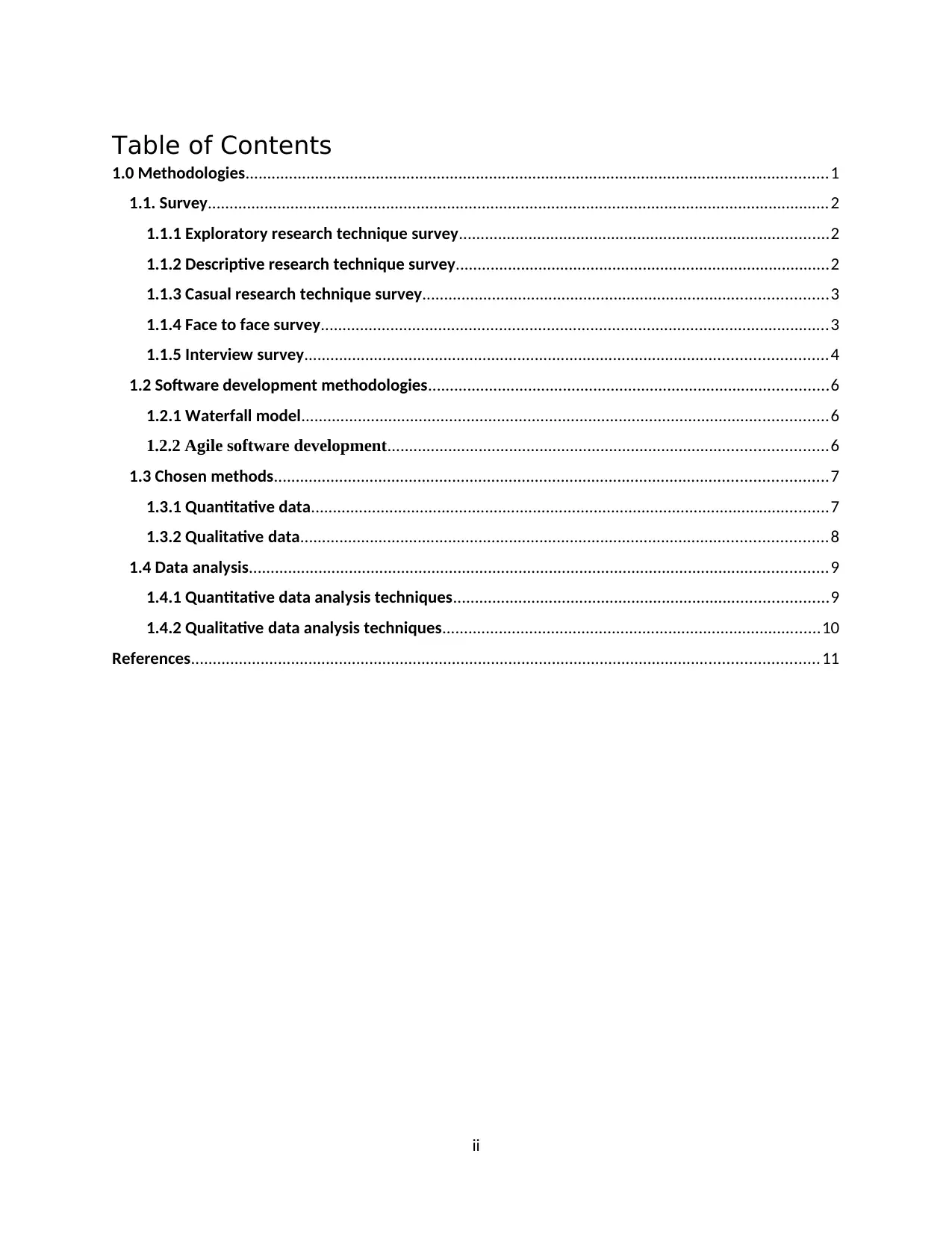
Table of Contents
1.0 Methodologies......................................................................................................................................1
1.1. Survey...............................................................................................................................................2
1.1.1 Exploratory research technique survey.....................................................................................2
1.1.2 Descriptive research technique survey......................................................................................2
1.1.3 Casual research technique survey.............................................................................................3
1.1.4 Face to face survey.....................................................................................................................3
1.1.5 Interview survey........................................................................................................................4
1.2 Software development methodologies............................................................................................6
1.2.1 Waterfall model.........................................................................................................................6
1.2.2 Agile software development.....................................................................................................6
1.3 Chosen methods...............................................................................................................................7
1.3.1 Quantitative data.......................................................................................................................7
1.3.2 Qualitative data.........................................................................................................................8
1.4 Data analysis.....................................................................................................................................9
1.4.1 Quantitative data analysis techniques......................................................................................9
1.4.2 Qualitative data analysis techniques.......................................................................................10
References................................................................................................................................................11
ii
1.0 Methodologies......................................................................................................................................1
1.1. Survey...............................................................................................................................................2
1.1.1 Exploratory research technique survey.....................................................................................2
1.1.2 Descriptive research technique survey......................................................................................2
1.1.3 Casual research technique survey.............................................................................................3
1.1.4 Face to face survey.....................................................................................................................3
1.1.5 Interview survey........................................................................................................................4
1.2 Software development methodologies............................................................................................6
1.2.1 Waterfall model.........................................................................................................................6
1.2.2 Agile software development.....................................................................................................6
1.3 Chosen methods...............................................................................................................................7
1.3.1 Quantitative data.......................................................................................................................7
1.3.2 Qualitative data.........................................................................................................................8
1.4 Data analysis.....................................................................................................................................9
1.4.1 Quantitative data analysis techniques......................................................................................9
1.4.2 Qualitative data analysis techniques.......................................................................................10
References................................................................................................................................................11
ii
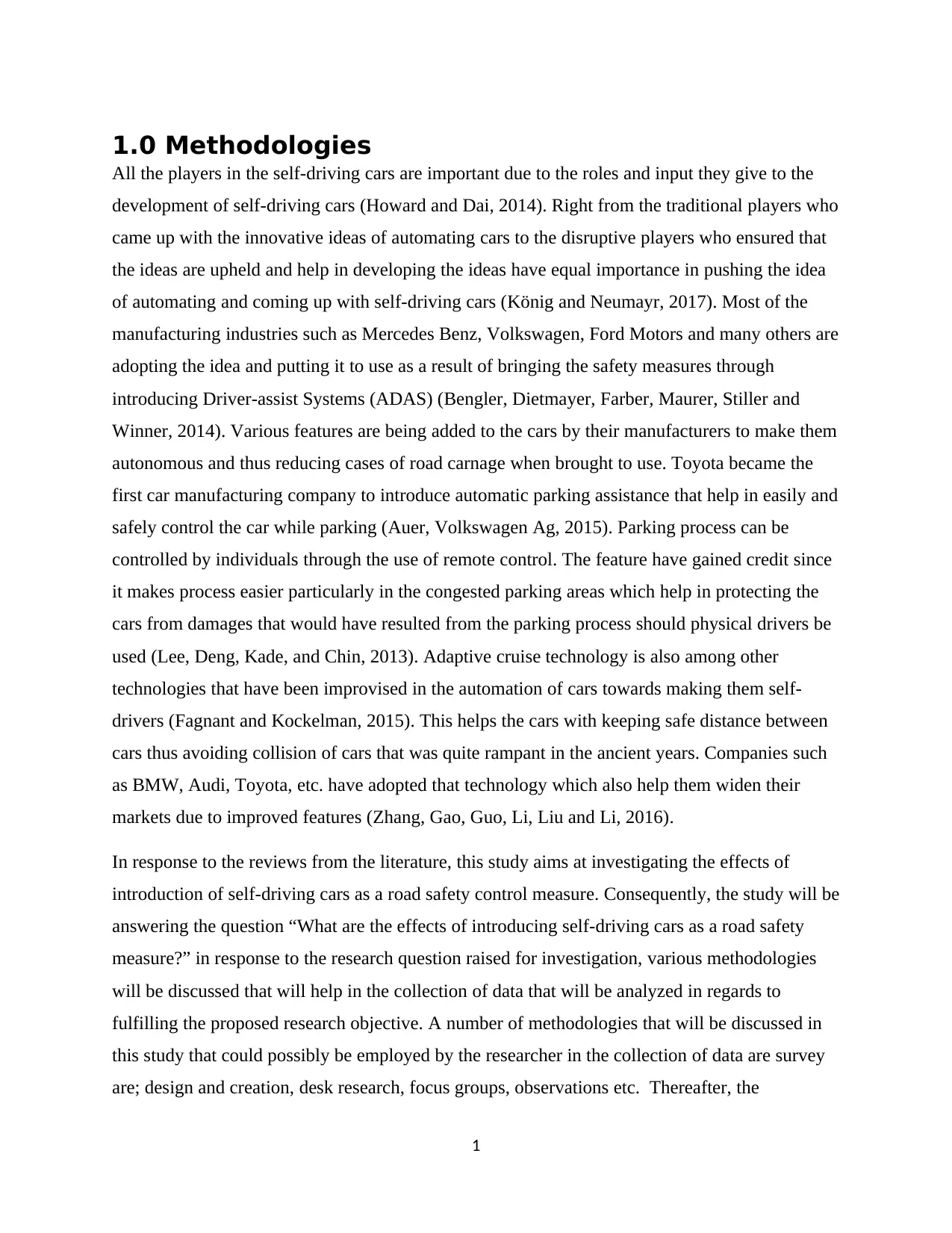
1.0 Methodologies
All the players in the self-driving cars are important due to the roles and input they give to the
development of self-driving cars (Howard and Dai, 2014). Right from the traditional players who
came up with the innovative ideas of automating cars to the disruptive players who ensured that
the ideas are upheld and help in developing the ideas have equal importance in pushing the idea
of automating and coming up with self-driving cars (König and Neumayr, 2017). Most of the
manufacturing industries such as Mercedes Benz, Volkswagen, Ford Motors and many others are
adopting the idea and putting it to use as a result of bringing the safety measures through
introducing Driver-assist Systems (ADAS) (Bengler, Dietmayer, Farber, Maurer, Stiller and
Winner, 2014). Various features are being added to the cars by their manufacturers to make them
autonomous and thus reducing cases of road carnage when brought to use. Toyota became the
first car manufacturing company to introduce automatic parking assistance that help in easily and
safely control the car while parking (Auer, Volkswagen Ag, 2015). Parking process can be
controlled by individuals through the use of remote control. The feature have gained credit since
it makes process easier particularly in the congested parking areas which help in protecting the
cars from damages that would have resulted from the parking process should physical drivers be
used (Lee, Deng, Kade, and Chin, 2013). Adaptive cruise technology is also among other
technologies that have been improvised in the automation of cars towards making them self-
drivers (Fagnant and Kockelman, 2015). This helps the cars with keeping safe distance between
cars thus avoiding collision of cars that was quite rampant in the ancient years. Companies such
as BMW, Audi, Toyota, etc. have adopted that technology which also help them widen their
markets due to improved features (Zhang, Gao, Guo, Li, Liu and Li, 2016).
In response to the reviews from the literature, this study aims at investigating the effects of
introduction of self-driving cars as a road safety control measure. Consequently, the study will be
answering the question “What are the effects of introducing self-driving cars as a road safety
measure?” in response to the research question raised for investigation, various methodologies
will be discussed that will help in the collection of data that will be analyzed in regards to
fulfilling the proposed research objective. A number of methodologies that will be discussed in
this study that could possibly be employed by the researcher in the collection of data are survey
are; design and creation, desk research, focus groups, observations etc. Thereafter, the
1
All the players in the self-driving cars are important due to the roles and input they give to the
development of self-driving cars (Howard and Dai, 2014). Right from the traditional players who
came up with the innovative ideas of automating cars to the disruptive players who ensured that
the ideas are upheld and help in developing the ideas have equal importance in pushing the idea
of automating and coming up with self-driving cars (König and Neumayr, 2017). Most of the
manufacturing industries such as Mercedes Benz, Volkswagen, Ford Motors and many others are
adopting the idea and putting it to use as a result of bringing the safety measures through
introducing Driver-assist Systems (ADAS) (Bengler, Dietmayer, Farber, Maurer, Stiller and
Winner, 2014). Various features are being added to the cars by their manufacturers to make them
autonomous and thus reducing cases of road carnage when brought to use. Toyota became the
first car manufacturing company to introduce automatic parking assistance that help in easily and
safely control the car while parking (Auer, Volkswagen Ag, 2015). Parking process can be
controlled by individuals through the use of remote control. The feature have gained credit since
it makes process easier particularly in the congested parking areas which help in protecting the
cars from damages that would have resulted from the parking process should physical drivers be
used (Lee, Deng, Kade, and Chin, 2013). Adaptive cruise technology is also among other
technologies that have been improvised in the automation of cars towards making them self-
drivers (Fagnant and Kockelman, 2015). This helps the cars with keeping safe distance between
cars thus avoiding collision of cars that was quite rampant in the ancient years. Companies such
as BMW, Audi, Toyota, etc. have adopted that technology which also help them widen their
markets due to improved features (Zhang, Gao, Guo, Li, Liu and Li, 2016).
In response to the reviews from the literature, this study aims at investigating the effects of
introduction of self-driving cars as a road safety control measure. Consequently, the study will be
answering the question “What are the effects of introducing self-driving cars as a road safety
measure?” in response to the research question raised for investigation, various methodologies
will be discussed that will help in the collection of data that will be analyzed in regards to
fulfilling the proposed research objective. A number of methodologies that will be discussed in
this study that could possibly be employed by the researcher in the collection of data are survey
are; design and creation, desk research, focus groups, observations etc. Thereafter, the
1
⊘ This is a preview!⊘
Do you want full access?
Subscribe today to unlock all pages.

Trusted by 1+ million students worldwide
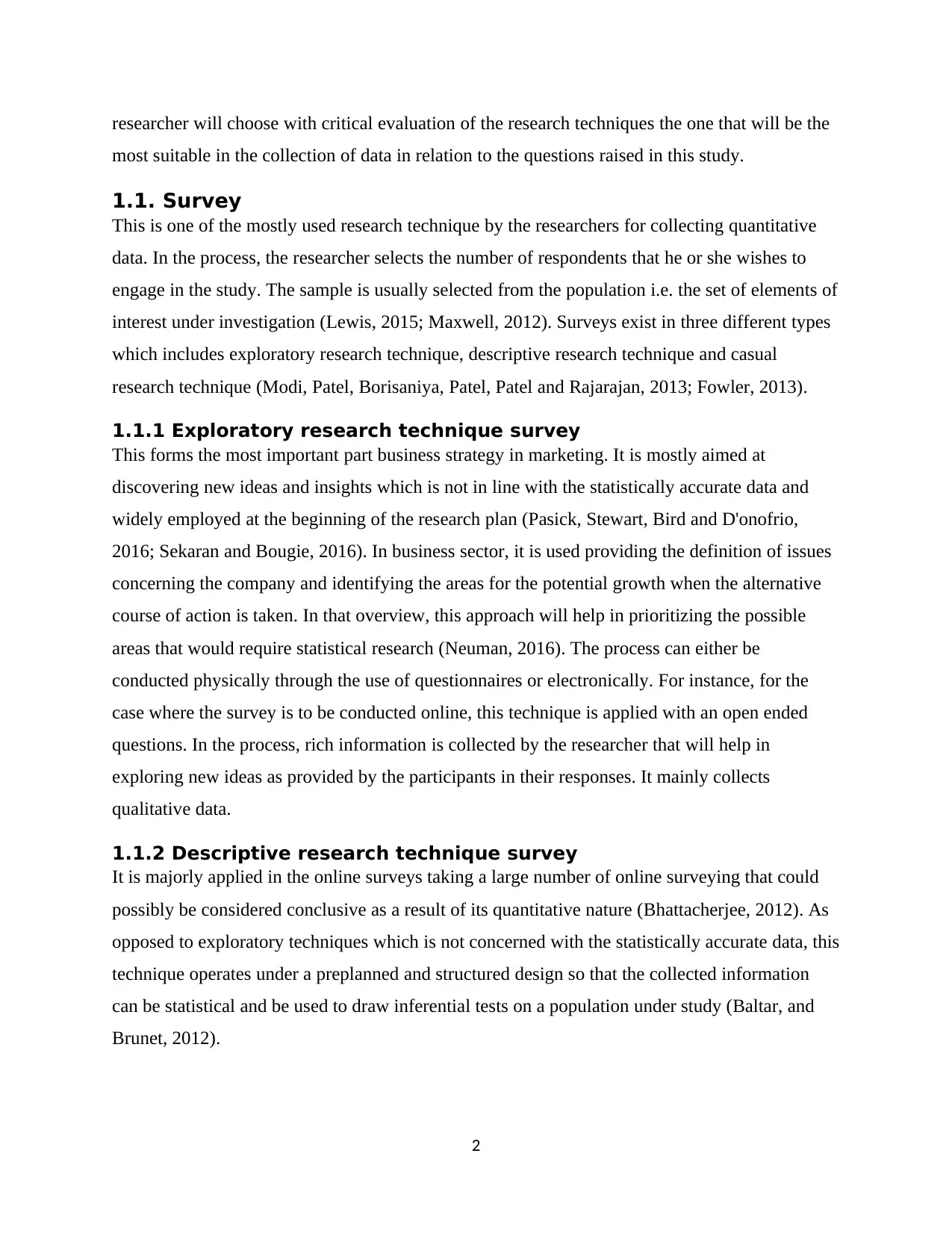
researcher will choose with critical evaluation of the research techniques the one that will be the
most suitable in the collection of data in relation to the questions raised in this study.
1.1. Survey
This is one of the mostly used research technique by the researchers for collecting quantitative
data. In the process, the researcher selects the number of respondents that he or she wishes to
engage in the study. The sample is usually selected from the population i.e. the set of elements of
interest under investigation (Lewis, 2015; Maxwell, 2012). Surveys exist in three different types
which includes exploratory research technique, descriptive research technique and casual
research technique (Modi, Patel, Borisaniya, Patel, Patel and Rajarajan, 2013; Fowler, 2013).
1.1.1 Exploratory research technique survey
This forms the most important part business strategy in marketing. It is mostly aimed at
discovering new ideas and insights which is not in line with the statistically accurate data and
widely employed at the beginning of the research plan (Pasick, Stewart, Bird and D'onofrio,
2016; Sekaran and Bougie, 2016). In business sector, it is used providing the definition of issues
concerning the company and identifying the areas for the potential growth when the alternative
course of action is taken. In that overview, this approach will help in prioritizing the possible
areas that would require statistical research (Neuman, 2016). The process can either be
conducted physically through the use of questionnaires or electronically. For instance, for the
case where the survey is to be conducted online, this technique is applied with an open ended
questions. In the process, rich information is collected by the researcher that will help in
exploring new ideas as provided by the participants in their responses. It mainly collects
qualitative data.
1.1.2 Descriptive research technique survey
It is majorly applied in the online surveys taking a large number of online surveying that could
possibly be considered conclusive as a result of its quantitative nature (Bhattacherjee, 2012). As
opposed to exploratory techniques which is not concerned with the statistically accurate data, this
technique operates under a preplanned and structured design so that the collected information
can be statistical and be used to draw inferential tests on a population under study (Baltar, and
Brunet, 2012).
2
most suitable in the collection of data in relation to the questions raised in this study.
1.1. Survey
This is one of the mostly used research technique by the researchers for collecting quantitative
data. In the process, the researcher selects the number of respondents that he or she wishes to
engage in the study. The sample is usually selected from the population i.e. the set of elements of
interest under investigation (Lewis, 2015; Maxwell, 2012). Surveys exist in three different types
which includes exploratory research technique, descriptive research technique and casual
research technique (Modi, Patel, Borisaniya, Patel, Patel and Rajarajan, 2013; Fowler, 2013).
1.1.1 Exploratory research technique survey
This forms the most important part business strategy in marketing. It is mostly aimed at
discovering new ideas and insights which is not in line with the statistically accurate data and
widely employed at the beginning of the research plan (Pasick, Stewart, Bird and D'onofrio,
2016; Sekaran and Bougie, 2016). In business sector, it is used providing the definition of issues
concerning the company and identifying the areas for the potential growth when the alternative
course of action is taken. In that overview, this approach will help in prioritizing the possible
areas that would require statistical research (Neuman, 2016). The process can either be
conducted physically through the use of questionnaires or electronically. For instance, for the
case where the survey is to be conducted online, this technique is applied with an open ended
questions. In the process, rich information is collected by the researcher that will help in
exploring new ideas as provided by the participants in their responses. It mainly collects
qualitative data.
1.1.2 Descriptive research technique survey
It is majorly applied in the online surveys taking a large number of online surveying that could
possibly be considered conclusive as a result of its quantitative nature (Bhattacherjee, 2012). As
opposed to exploratory techniques which is not concerned with the statistically accurate data, this
technique operates under a preplanned and structured design so that the collected information
can be statistical and be used to draw inferential tests on a population under study (Baltar, and
Brunet, 2012).
2
Paraphrase This Document
Need a fresh take? Get an instant paraphrase of this document with our AI Paraphraser
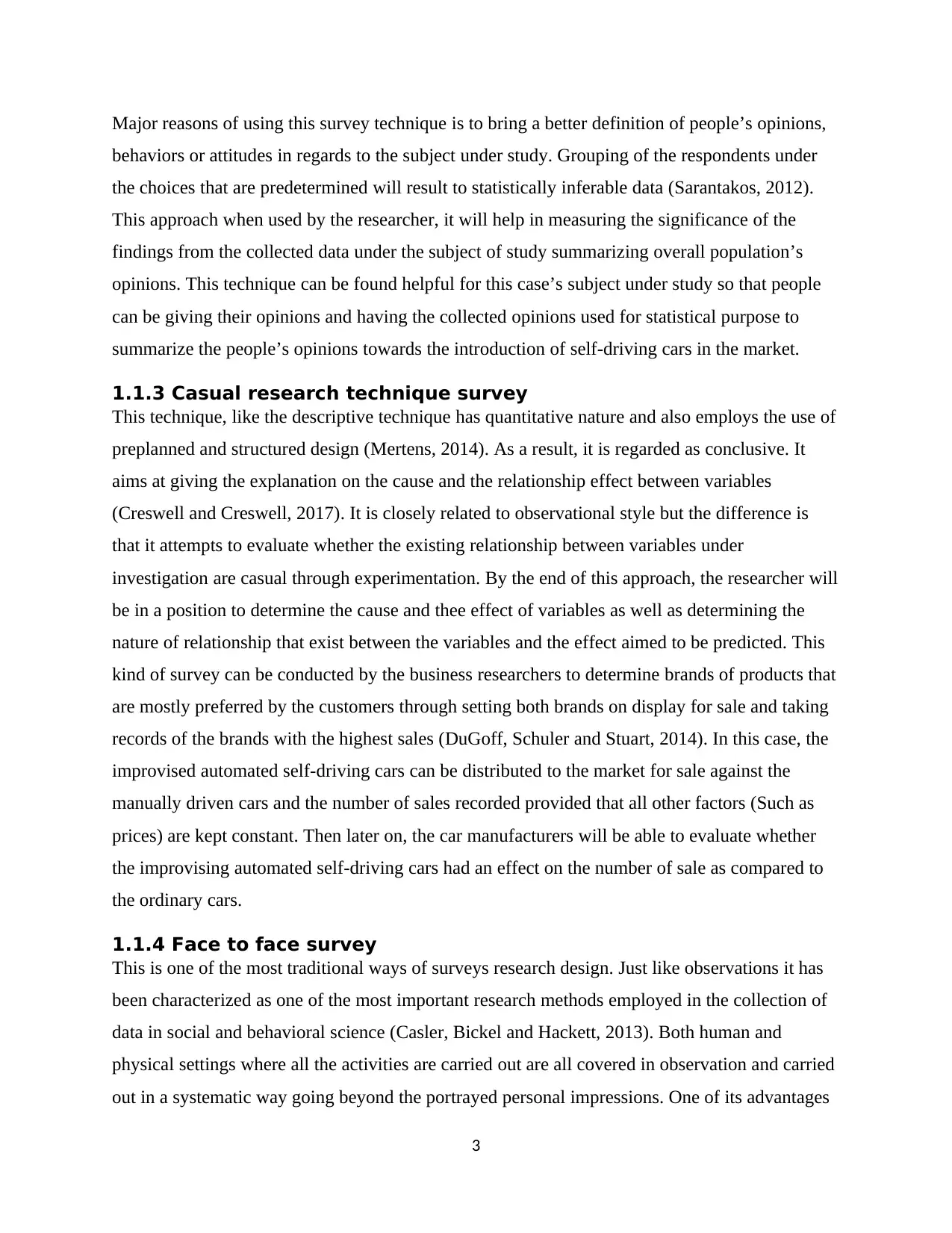
Major reasons of using this survey technique is to bring a better definition of people’s opinions,
behaviors or attitudes in regards to the subject under study. Grouping of the respondents under
the choices that are predetermined will result to statistically inferable data (Sarantakos, 2012).
This approach when used by the researcher, it will help in measuring the significance of the
findings from the collected data under the subject of study summarizing overall population’s
opinions. This technique can be found helpful for this case’s subject under study so that people
can be giving their opinions and having the collected opinions used for statistical purpose to
summarize the people’s opinions towards the introduction of self-driving cars in the market.
1.1.3 Casual research technique survey
This technique, like the descriptive technique has quantitative nature and also employs the use of
preplanned and structured design (Mertens, 2014). As a result, it is regarded as conclusive. It
aims at giving the explanation on the cause and the relationship effect between variables
(Creswell and Creswell, 2017). It is closely related to observational style but the difference is
that it attempts to evaluate whether the existing relationship between variables under
investigation are casual through experimentation. By the end of this approach, the researcher will
be in a position to determine the cause and thee effect of variables as well as determining the
nature of relationship that exist between the variables and the effect aimed to be predicted. This
kind of survey can be conducted by the business researchers to determine brands of products that
are mostly preferred by the customers through setting both brands on display for sale and taking
records of the brands with the highest sales (DuGoff, Schuler and Stuart, 2014). In this case, the
improvised automated self-driving cars can be distributed to the market for sale against the
manually driven cars and the number of sales recorded provided that all other factors (Such as
prices) are kept constant. Then later on, the car manufacturers will be able to evaluate whether
the improvising automated self-driving cars had an effect on the number of sale as compared to
the ordinary cars.
1.1.4 Face to face survey
This is one of the most traditional ways of surveys research design. Just like observations it has
been characterized as one of the most important research methods employed in the collection of
data in social and behavioral science (Casler, Bickel and Hackett, 2013). Both human and
physical settings where all the activities are carried out are all covered in observation and carried
out in a systematic way going beyond the portrayed personal impressions. One of its advantages
3
behaviors or attitudes in regards to the subject under study. Grouping of the respondents under
the choices that are predetermined will result to statistically inferable data (Sarantakos, 2012).
This approach when used by the researcher, it will help in measuring the significance of the
findings from the collected data under the subject of study summarizing overall population’s
opinions. This technique can be found helpful for this case’s subject under study so that people
can be giving their opinions and having the collected opinions used for statistical purpose to
summarize the people’s opinions towards the introduction of self-driving cars in the market.
1.1.3 Casual research technique survey
This technique, like the descriptive technique has quantitative nature and also employs the use of
preplanned and structured design (Mertens, 2014). As a result, it is regarded as conclusive. It
aims at giving the explanation on the cause and the relationship effect between variables
(Creswell and Creswell, 2017). It is closely related to observational style but the difference is
that it attempts to evaluate whether the existing relationship between variables under
investigation are casual through experimentation. By the end of this approach, the researcher will
be in a position to determine the cause and thee effect of variables as well as determining the
nature of relationship that exist between the variables and the effect aimed to be predicted. This
kind of survey can be conducted by the business researchers to determine brands of products that
are mostly preferred by the customers through setting both brands on display for sale and taking
records of the brands with the highest sales (DuGoff, Schuler and Stuart, 2014). In this case, the
improvised automated self-driving cars can be distributed to the market for sale against the
manually driven cars and the number of sales recorded provided that all other factors (Such as
prices) are kept constant. Then later on, the car manufacturers will be able to evaluate whether
the improvising automated self-driving cars had an effect on the number of sale as compared to
the ordinary cars.
1.1.4 Face to face survey
This is one of the most traditional ways of surveys research design. Just like observations it has
been characterized as one of the most important research methods employed in the collection of
data in social and behavioral science (Casler, Bickel and Hackett, 2013). Both human and
physical settings where all the activities are carried out are all covered in observation and carried
out in a systematic way going beyond the portrayed personal impressions. One of its advantages
3
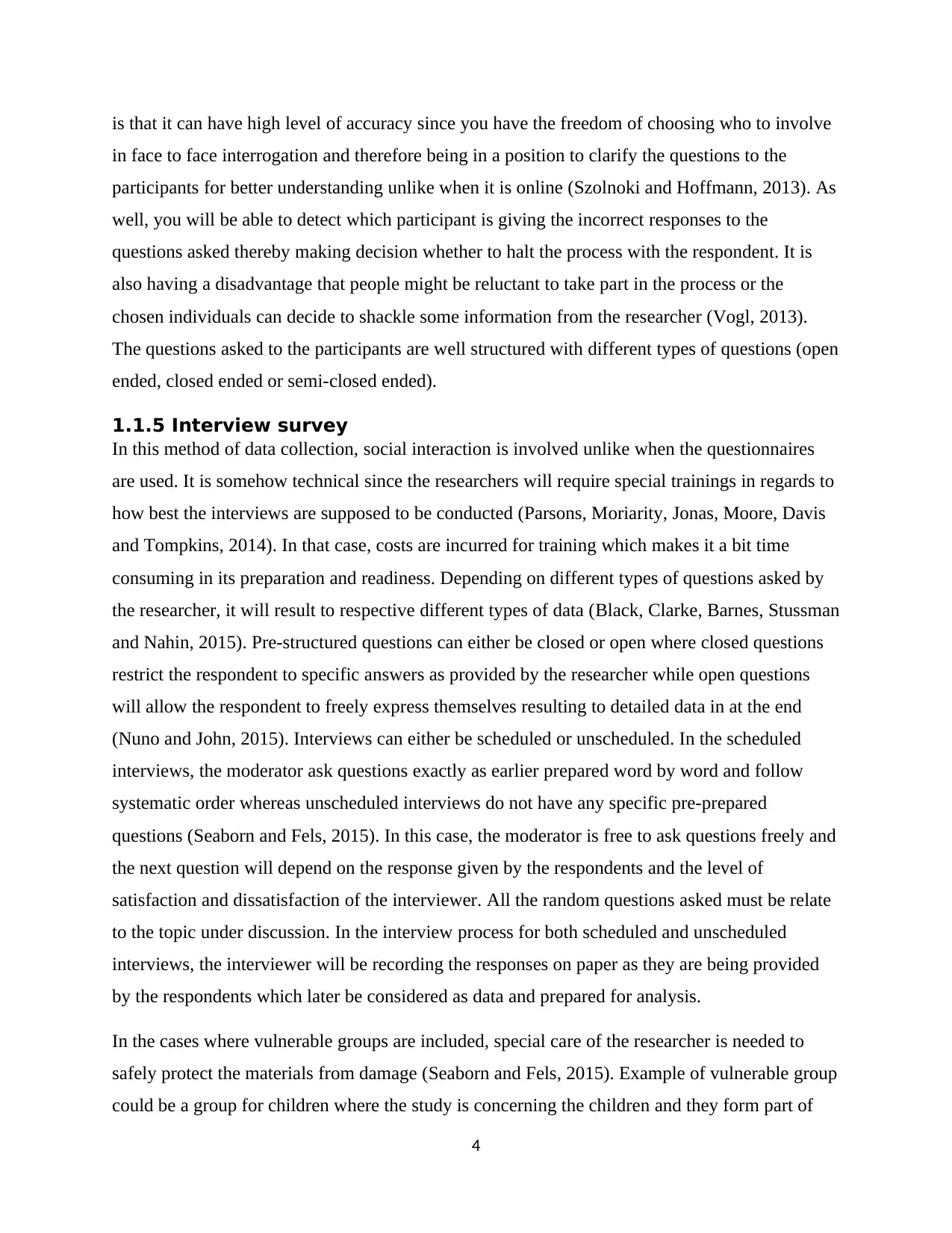
is that it can have high level of accuracy since you have the freedom of choosing who to involve
in face to face interrogation and therefore being in a position to clarify the questions to the
participants for better understanding unlike when it is online (Szolnoki and Hoffmann, 2013). As
well, you will be able to detect which participant is giving the incorrect responses to the
questions asked thereby making decision whether to halt the process with the respondent. It is
also having a disadvantage that people might be reluctant to take part in the process or the
chosen individuals can decide to shackle some information from the researcher (Vogl, 2013).
The questions asked to the participants are well structured with different types of questions (open
ended, closed ended or semi-closed ended).
1.1.5 Interview survey
In this method of data collection, social interaction is involved unlike when the questionnaires
are used. It is somehow technical since the researchers will require special trainings in regards to
how best the interviews are supposed to be conducted (Parsons, Moriarity, Jonas, Moore, Davis
and Tompkins, 2014). In that case, costs are incurred for training which makes it a bit time
consuming in its preparation and readiness. Depending on different types of questions asked by
the researcher, it will result to respective different types of data (Black, Clarke, Barnes, Stussman
and Nahin, 2015). Pre-structured questions can either be closed or open where closed questions
restrict the respondent to specific answers as provided by the researcher while open questions
will allow the respondent to freely express themselves resulting to detailed data in at the end
(Nuno and John, 2015). Interviews can either be scheduled or unscheduled. In the scheduled
interviews, the moderator ask questions exactly as earlier prepared word by word and follow
systematic order whereas unscheduled interviews do not have any specific pre-prepared
questions (Seaborn and Fels, 2015). In this case, the moderator is free to ask questions freely and
the next question will depend on the response given by the respondents and the level of
satisfaction and dissatisfaction of the interviewer. All the random questions asked must be relate
to the topic under discussion. In the interview process for both scheduled and unscheduled
interviews, the interviewer will be recording the responses on paper as they are being provided
by the respondents which later be considered as data and prepared for analysis.
In the cases where vulnerable groups are included, special care of the researcher is needed to
safely protect the materials from damage (Seaborn and Fels, 2015). Example of vulnerable group
could be a group for children where the study is concerning the children and they form part of
4
in face to face interrogation and therefore being in a position to clarify the questions to the
participants for better understanding unlike when it is online (Szolnoki and Hoffmann, 2013). As
well, you will be able to detect which participant is giving the incorrect responses to the
questions asked thereby making decision whether to halt the process with the respondent. It is
also having a disadvantage that people might be reluctant to take part in the process or the
chosen individuals can decide to shackle some information from the researcher (Vogl, 2013).
The questions asked to the participants are well structured with different types of questions (open
ended, closed ended or semi-closed ended).
1.1.5 Interview survey
In this method of data collection, social interaction is involved unlike when the questionnaires
are used. It is somehow technical since the researchers will require special trainings in regards to
how best the interviews are supposed to be conducted (Parsons, Moriarity, Jonas, Moore, Davis
and Tompkins, 2014). In that case, costs are incurred for training which makes it a bit time
consuming in its preparation and readiness. Depending on different types of questions asked by
the researcher, it will result to respective different types of data (Black, Clarke, Barnes, Stussman
and Nahin, 2015). Pre-structured questions can either be closed or open where closed questions
restrict the respondent to specific answers as provided by the researcher while open questions
will allow the respondent to freely express themselves resulting to detailed data in at the end
(Nuno and John, 2015). Interviews can either be scheduled or unscheduled. In the scheduled
interviews, the moderator ask questions exactly as earlier prepared word by word and follow
systematic order whereas unscheduled interviews do not have any specific pre-prepared
questions (Seaborn and Fels, 2015). In this case, the moderator is free to ask questions freely and
the next question will depend on the response given by the respondents and the level of
satisfaction and dissatisfaction of the interviewer. All the random questions asked must be relate
to the topic under discussion. In the interview process for both scheduled and unscheduled
interviews, the interviewer will be recording the responses on paper as they are being provided
by the respondents which later be considered as data and prepared for analysis.
In the cases where vulnerable groups are included, special care of the researcher is needed to
safely protect the materials from damage (Seaborn and Fels, 2015). Example of vulnerable group
could be a group for children where the study is concerning the children and they form part of
4
⊘ This is a preview!⊘
Do you want full access?
Subscribe today to unlock all pages.

Trusted by 1+ million students worldwide
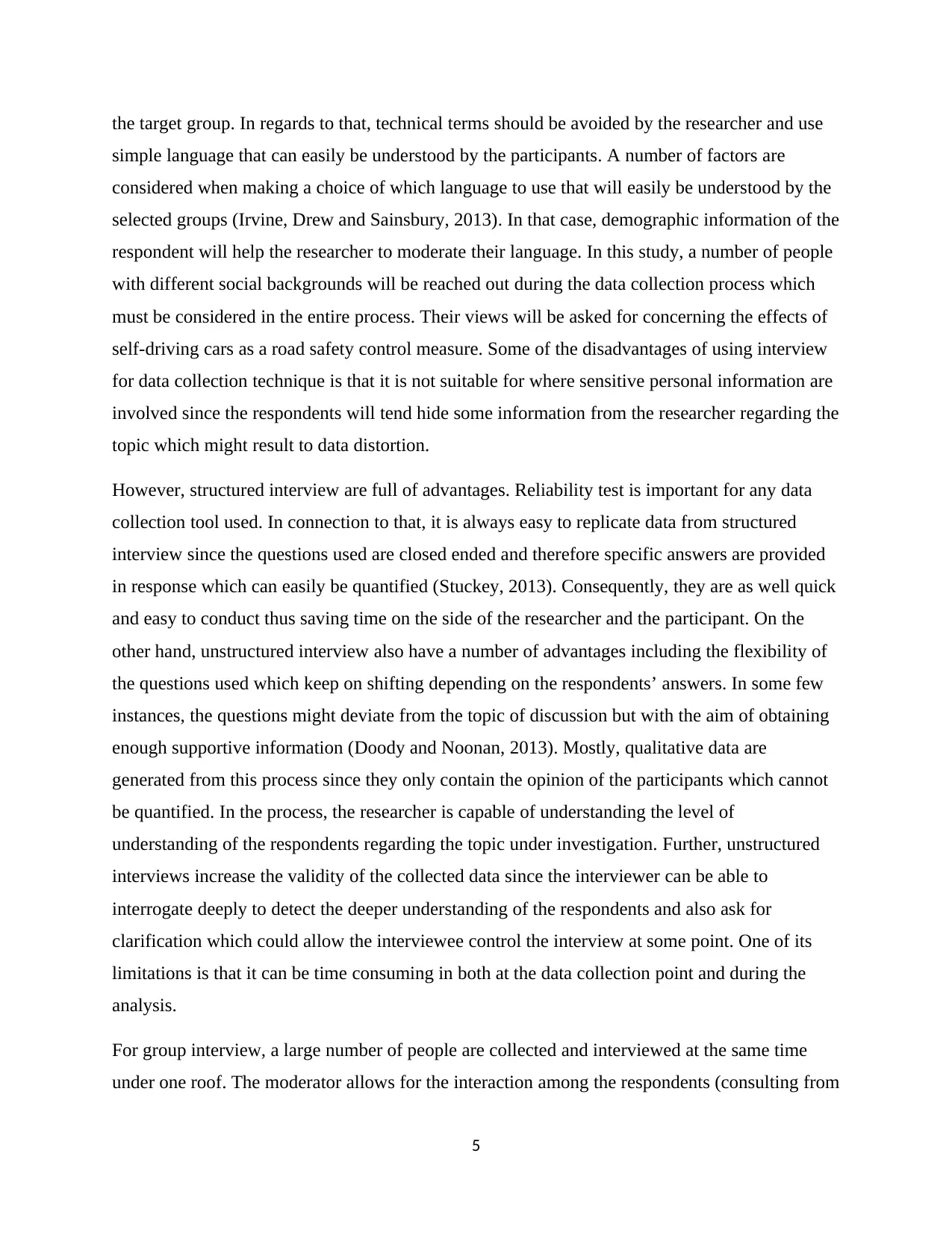
the target group. In regards to that, technical terms should be avoided by the researcher and use
simple language that can easily be understood by the participants. A number of factors are
considered when making a choice of which language to use that will easily be understood by the
selected groups (Irvine, Drew and Sainsbury, 2013). In that case, demographic information of the
respondent will help the researcher to moderate their language. In this study, a number of people
with different social backgrounds will be reached out during the data collection process which
must be considered in the entire process. Their views will be asked for concerning the effects of
self-driving cars as a road safety control measure. Some of the disadvantages of using interview
for data collection technique is that it is not suitable for where sensitive personal information are
involved since the respondents will tend hide some information from the researcher regarding the
topic which might result to data distortion.
However, structured interview are full of advantages. Reliability test is important for any data
collection tool used. In connection to that, it is always easy to replicate data from structured
interview since the questions used are closed ended and therefore specific answers are provided
in response which can easily be quantified (Stuckey, 2013). Consequently, they are as well quick
and easy to conduct thus saving time on the side of the researcher and the participant. On the
other hand, unstructured interview also have a number of advantages including the flexibility of
the questions used which keep on shifting depending on the respondents’ answers. In some few
instances, the questions might deviate from the topic of discussion but with the aim of obtaining
enough supportive information (Doody and Noonan, 2013). Mostly, qualitative data are
generated from this process since they only contain the opinion of the participants which cannot
be quantified. In the process, the researcher is capable of understanding the level of
understanding of the respondents regarding the topic under investigation. Further, unstructured
interviews increase the validity of the collected data since the interviewer can be able to
interrogate deeply to detect the deeper understanding of the respondents and also ask for
clarification which could allow the interviewee control the interview at some point. One of its
limitations is that it can be time consuming in both at the data collection point and during the
analysis.
For group interview, a large number of people are collected and interviewed at the same time
under one roof. The moderator allows for the interaction among the respondents (consulting from
5
simple language that can easily be understood by the participants. A number of factors are
considered when making a choice of which language to use that will easily be understood by the
selected groups (Irvine, Drew and Sainsbury, 2013). In that case, demographic information of the
respondent will help the researcher to moderate their language. In this study, a number of people
with different social backgrounds will be reached out during the data collection process which
must be considered in the entire process. Their views will be asked for concerning the effects of
self-driving cars as a road safety control measure. Some of the disadvantages of using interview
for data collection technique is that it is not suitable for where sensitive personal information are
involved since the respondents will tend hide some information from the researcher regarding the
topic which might result to data distortion.
However, structured interview are full of advantages. Reliability test is important for any data
collection tool used. In connection to that, it is always easy to replicate data from structured
interview since the questions used are closed ended and therefore specific answers are provided
in response which can easily be quantified (Stuckey, 2013). Consequently, they are as well quick
and easy to conduct thus saving time on the side of the researcher and the participant. On the
other hand, unstructured interview also have a number of advantages including the flexibility of
the questions used which keep on shifting depending on the respondents’ answers. In some few
instances, the questions might deviate from the topic of discussion but with the aim of obtaining
enough supportive information (Doody and Noonan, 2013). Mostly, qualitative data are
generated from this process since they only contain the opinion of the participants which cannot
be quantified. In the process, the researcher is capable of understanding the level of
understanding of the respondents regarding the topic under investigation. Further, unstructured
interviews increase the validity of the collected data since the interviewer can be able to
interrogate deeply to detect the deeper understanding of the respondents and also ask for
clarification which could allow the interviewee control the interview at some point. One of its
limitations is that it can be time consuming in both at the data collection point and during the
analysis.
For group interview, a large number of people are collected and interviewed at the same time
under one roof. The moderator allows for the interaction among the respondents (consulting from
5
Paraphrase This Document
Need a fresh take? Get an instant paraphrase of this document with our AI Paraphraser
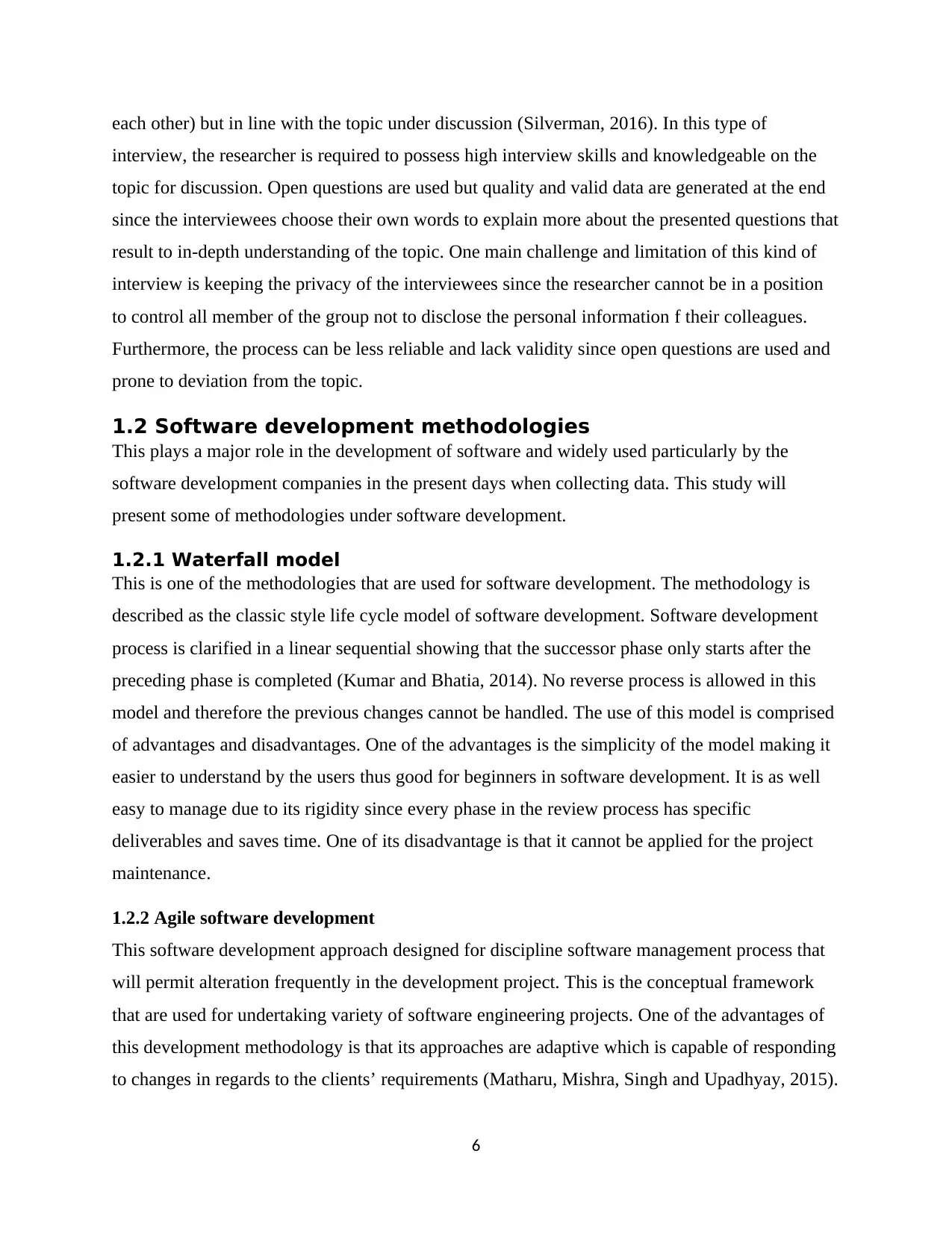
each other) but in line with the topic under discussion (Silverman, 2016). In this type of
interview, the researcher is required to possess high interview skills and knowledgeable on the
topic for discussion. Open questions are used but quality and valid data are generated at the end
since the interviewees choose their own words to explain more about the presented questions that
result to in-depth understanding of the topic. One main challenge and limitation of this kind of
interview is keeping the privacy of the interviewees since the researcher cannot be in a position
to control all member of the group not to disclose the personal information f their colleagues.
Furthermore, the process can be less reliable and lack validity since open questions are used and
prone to deviation from the topic.
1.2 Software development methodologies
This plays a major role in the development of software and widely used particularly by the
software development companies in the present days when collecting data. This study will
present some of methodologies under software development.
1.2.1 Waterfall model
This is one of the methodologies that are used for software development. The methodology is
described as the classic style life cycle model of software development. Software development
process is clarified in a linear sequential showing that the successor phase only starts after the
preceding phase is completed (Kumar and Bhatia, 2014). No reverse process is allowed in this
model and therefore the previous changes cannot be handled. The use of this model is comprised
of advantages and disadvantages. One of the advantages is the simplicity of the model making it
easier to understand by the users thus good for beginners in software development. It is as well
easy to manage due to its rigidity since every phase in the review process has specific
deliverables and saves time. One of its disadvantage is that it cannot be applied for the project
maintenance.
1.2.2 Agile software development
This software development approach designed for discipline software management process that
will permit alteration frequently in the development project. This is the conceptual framework
that are used for undertaking variety of software engineering projects. One of the advantages of
this development methodology is that its approaches are adaptive which is capable of responding
to changes in regards to the clients’ requirements (Matharu, Mishra, Singh and Upadhyay, 2015).
6
interview, the researcher is required to possess high interview skills and knowledgeable on the
topic for discussion. Open questions are used but quality and valid data are generated at the end
since the interviewees choose their own words to explain more about the presented questions that
result to in-depth understanding of the topic. One main challenge and limitation of this kind of
interview is keeping the privacy of the interviewees since the researcher cannot be in a position
to control all member of the group not to disclose the personal information f their colleagues.
Furthermore, the process can be less reliable and lack validity since open questions are used and
prone to deviation from the topic.
1.2 Software development methodologies
This plays a major role in the development of software and widely used particularly by the
software development companies in the present days when collecting data. This study will
present some of methodologies under software development.
1.2.1 Waterfall model
This is one of the methodologies that are used for software development. The methodology is
described as the classic style life cycle model of software development. Software development
process is clarified in a linear sequential showing that the successor phase only starts after the
preceding phase is completed (Kumar and Bhatia, 2014). No reverse process is allowed in this
model and therefore the previous changes cannot be handled. The use of this model is comprised
of advantages and disadvantages. One of the advantages is the simplicity of the model making it
easier to understand by the users thus good for beginners in software development. It is as well
easy to manage due to its rigidity since every phase in the review process has specific
deliverables and saves time. One of its disadvantage is that it cannot be applied for the project
maintenance.
1.2.2 Agile software development
This software development approach designed for discipline software management process that
will permit alteration frequently in the development project. This is the conceptual framework
that are used for undertaking variety of software engineering projects. One of the advantages of
this development methodology is that its approaches are adaptive which is capable of responding
to changes in regards to the clients’ requirements (Matharu, Mishra, Singh and Upadhyay, 2015).
6
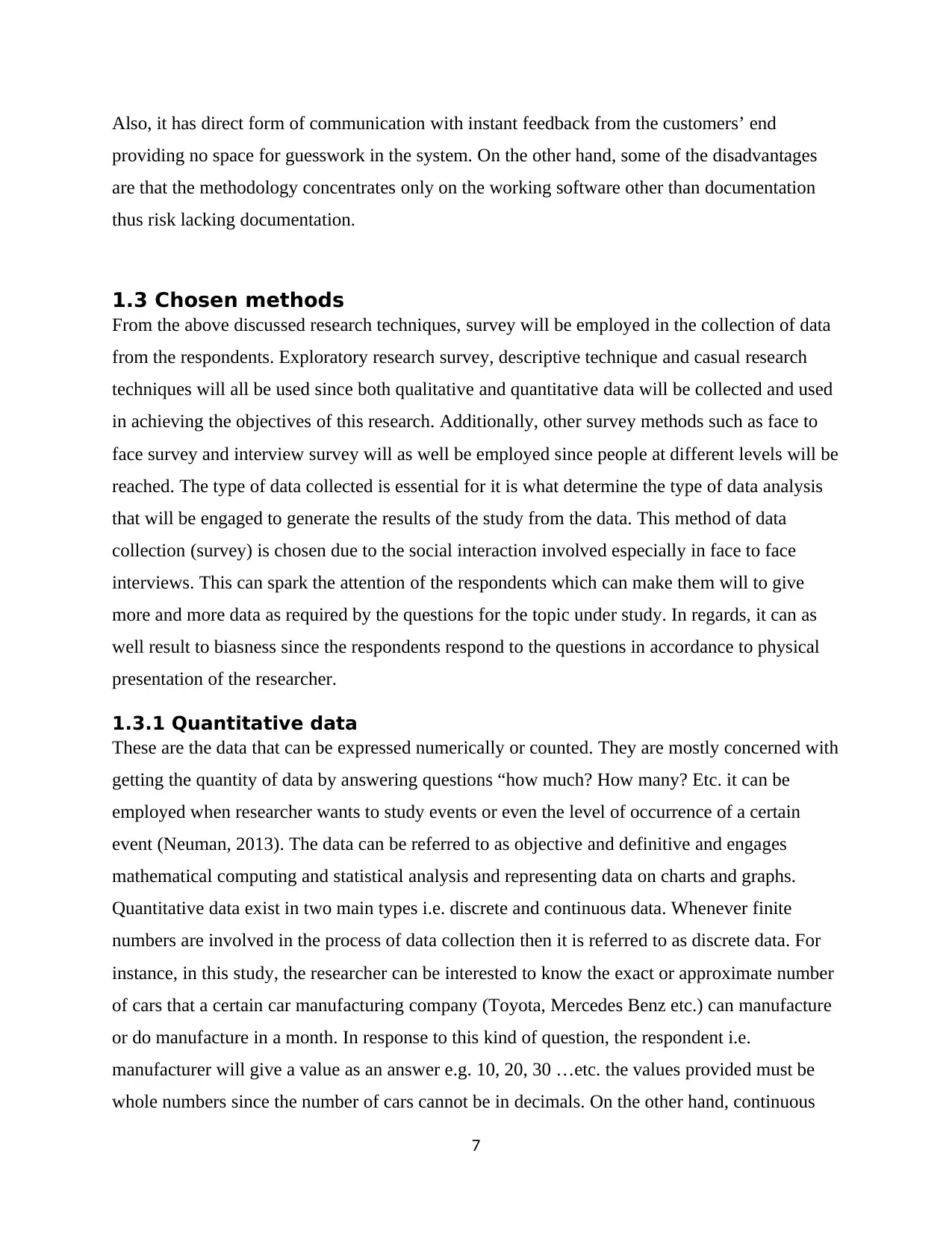
Also, it has direct form of communication with instant feedback from the customers’ end
providing no space for guesswork in the system. On the other hand, some of the disadvantages
are that the methodology concentrates only on the working software other than documentation
thus risk lacking documentation.
1.3 Chosen methods
From the above discussed research techniques, survey will be employed in the collection of data
from the respondents. Exploratory research survey, descriptive technique and casual research
techniques will all be used since both qualitative and quantitative data will be collected and used
in achieving the objectives of this research. Additionally, other survey methods such as face to
face survey and interview survey will as well be employed since people at different levels will be
reached. The type of data collected is essential for it is what determine the type of data analysis
that will be engaged to generate the results of the study from the data. This method of data
collection (survey) is chosen due to the social interaction involved especially in face to face
interviews. This can spark the attention of the respondents which can make them will to give
more and more data as required by the questions for the topic under study. In regards, it can as
well result to biasness since the respondents respond to the questions in accordance to physical
presentation of the researcher.
1.3.1 Quantitative data
These are the data that can be expressed numerically or counted. They are mostly concerned with
getting the quantity of data by answering questions “how much? How many? Etc. it can be
employed when researcher wants to study events or even the level of occurrence of a certain
event (Neuman, 2013). The data can be referred to as objective and definitive and engages
mathematical computing and statistical analysis and representing data on charts and graphs.
Quantitative data exist in two main types i.e. discrete and continuous data. Whenever finite
numbers are involved in the process of data collection then it is referred to as discrete data. For
instance, in this study, the researcher can be interested to know the exact or approximate number
of cars that a certain car manufacturing company (Toyota, Mercedes Benz etc.) can manufacture
or do manufacture in a month. In response to this kind of question, the respondent i.e.
manufacturer will give a value as an answer e.g. 10, 20, 30 …etc. the values provided must be
whole numbers since the number of cars cannot be in decimals. On the other hand, continuous
7
providing no space for guesswork in the system. On the other hand, some of the disadvantages
are that the methodology concentrates only on the working software other than documentation
thus risk lacking documentation.
1.3 Chosen methods
From the above discussed research techniques, survey will be employed in the collection of data
from the respondents. Exploratory research survey, descriptive technique and casual research
techniques will all be used since both qualitative and quantitative data will be collected and used
in achieving the objectives of this research. Additionally, other survey methods such as face to
face survey and interview survey will as well be employed since people at different levels will be
reached. The type of data collected is essential for it is what determine the type of data analysis
that will be engaged to generate the results of the study from the data. This method of data
collection (survey) is chosen due to the social interaction involved especially in face to face
interviews. This can spark the attention of the respondents which can make them will to give
more and more data as required by the questions for the topic under study. In regards, it can as
well result to biasness since the respondents respond to the questions in accordance to physical
presentation of the researcher.
1.3.1 Quantitative data
These are the data that can be expressed numerically or counted. They are mostly concerned with
getting the quantity of data by answering questions “how much? How many? Etc. it can be
employed when researcher wants to study events or even the level of occurrence of a certain
event (Neuman, 2013). The data can be referred to as objective and definitive and engages
mathematical computing and statistical analysis and representing data on charts and graphs.
Quantitative data exist in two main types i.e. discrete and continuous data. Whenever finite
numbers are involved in the process of data collection then it is referred to as discrete data. For
instance, in this study, the researcher can be interested to know the exact or approximate number
of cars that a certain car manufacturing company (Toyota, Mercedes Benz etc.) can manufacture
or do manufacture in a month. In response to this kind of question, the respondent i.e.
manufacturer will give a value as an answer e.g. 10, 20, 30 …etc. the values provided must be
whole numbers since the number of cars cannot be in decimals. On the other hand, continuous
7
⊘ This is a preview!⊘
Do you want full access?
Subscribe today to unlock all pages.

Trusted by 1+ million students worldwide
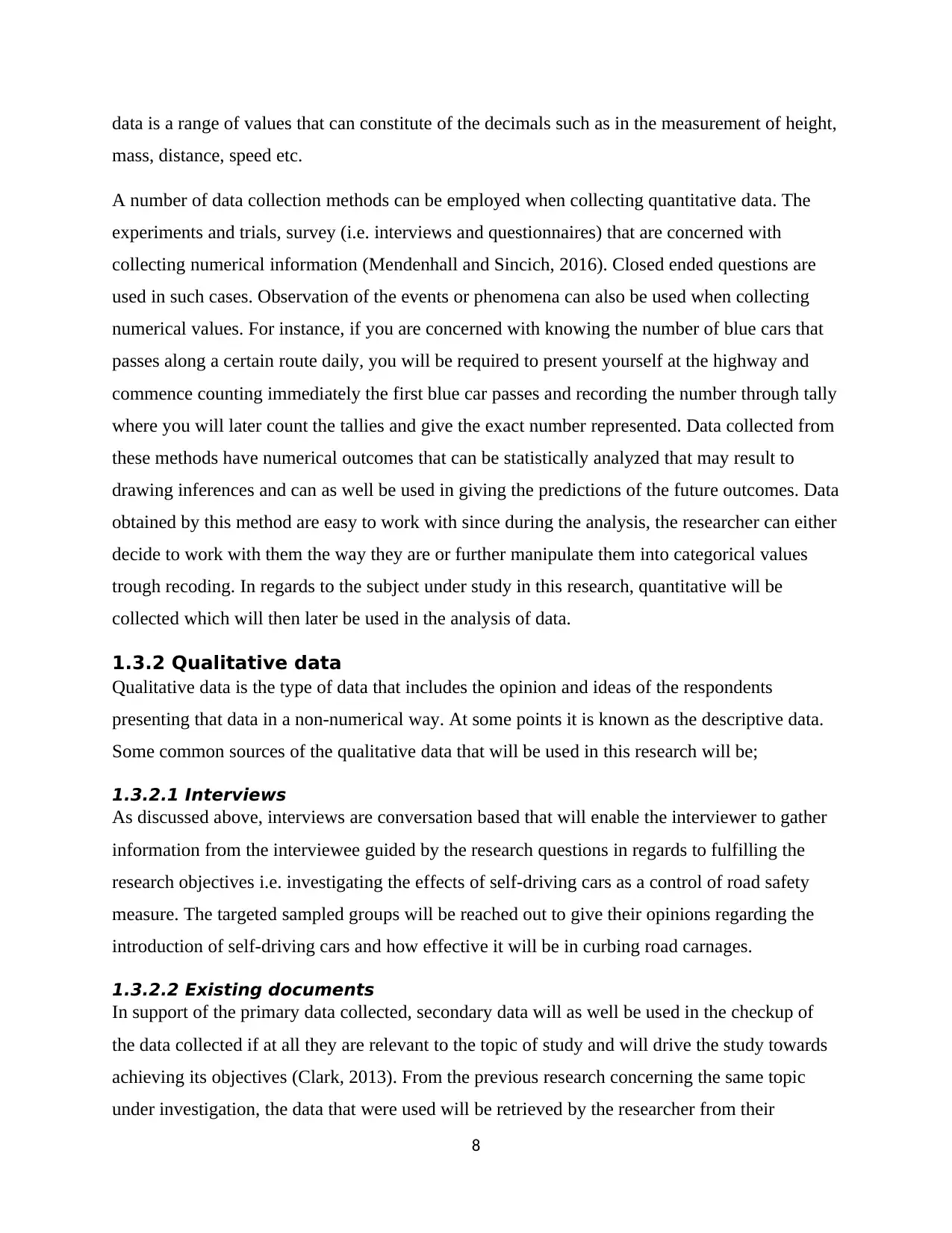
data is a range of values that can constitute of the decimals such as in the measurement of height,
mass, distance, speed etc.
A number of data collection methods can be employed when collecting quantitative data. The
experiments and trials, survey (i.e. interviews and questionnaires) that are concerned with
collecting numerical information (Mendenhall and Sincich, 2016). Closed ended questions are
used in such cases. Observation of the events or phenomena can also be used when collecting
numerical values. For instance, if you are concerned with knowing the number of blue cars that
passes along a certain route daily, you will be required to present yourself at the highway and
commence counting immediately the first blue car passes and recording the number through tally
where you will later count the tallies and give the exact number represented. Data collected from
these methods have numerical outcomes that can be statistically analyzed that may result to
drawing inferences and can as well be used in giving the predictions of the future outcomes. Data
obtained by this method are easy to work with since during the analysis, the researcher can either
decide to work with them the way they are or further manipulate them into categorical values
trough recoding. In regards to the subject under study in this research, quantitative will be
collected which will then later be used in the analysis of data.
1.3.2 Qualitative data
Qualitative data is the type of data that includes the opinion and ideas of the respondents
presenting that data in a non-numerical way. At some points it is known as the descriptive data.
Some common sources of the qualitative data that will be used in this research will be;
1.3.2.1 Interviews
As discussed above, interviews are conversation based that will enable the interviewer to gather
information from the interviewee guided by the research questions in regards to fulfilling the
research objectives i.e. investigating the effects of self-driving cars as a control of road safety
measure. The targeted sampled groups will be reached out to give their opinions regarding the
introduction of self-driving cars and how effective it will be in curbing road carnages.
1.3.2.2 Existing documents
In support of the primary data collected, secondary data will as well be used in the checkup of
the data collected if at all they are relevant to the topic of study and will drive the study towards
achieving its objectives (Clark, 2013). From the previous research concerning the same topic
under investigation, the data that were used will be retrieved by the researcher from their
8
mass, distance, speed etc.
A number of data collection methods can be employed when collecting quantitative data. The
experiments and trials, survey (i.e. interviews and questionnaires) that are concerned with
collecting numerical information (Mendenhall and Sincich, 2016). Closed ended questions are
used in such cases. Observation of the events or phenomena can also be used when collecting
numerical values. For instance, if you are concerned with knowing the number of blue cars that
passes along a certain route daily, you will be required to present yourself at the highway and
commence counting immediately the first blue car passes and recording the number through tally
where you will later count the tallies and give the exact number represented. Data collected from
these methods have numerical outcomes that can be statistically analyzed that may result to
drawing inferences and can as well be used in giving the predictions of the future outcomes. Data
obtained by this method are easy to work with since during the analysis, the researcher can either
decide to work with them the way they are or further manipulate them into categorical values
trough recoding. In regards to the subject under study in this research, quantitative will be
collected which will then later be used in the analysis of data.
1.3.2 Qualitative data
Qualitative data is the type of data that includes the opinion and ideas of the respondents
presenting that data in a non-numerical way. At some points it is known as the descriptive data.
Some common sources of the qualitative data that will be used in this research will be;
1.3.2.1 Interviews
As discussed above, interviews are conversation based that will enable the interviewer to gather
information from the interviewee guided by the research questions in regards to fulfilling the
research objectives i.e. investigating the effects of self-driving cars as a control of road safety
measure. The targeted sampled groups will be reached out to give their opinions regarding the
introduction of self-driving cars and how effective it will be in curbing road carnages.
1.3.2.2 Existing documents
In support of the primary data collected, secondary data will as well be used in the checkup of
the data collected if at all they are relevant to the topic of study and will drive the study towards
achieving its objectives (Clark, 2013). From the previous research concerning the same topic
under investigation, the data that were used will be retrieved by the researcher from their
8
Paraphrase This Document
Need a fresh take? Get an instant paraphrase of this document with our AI Paraphraser
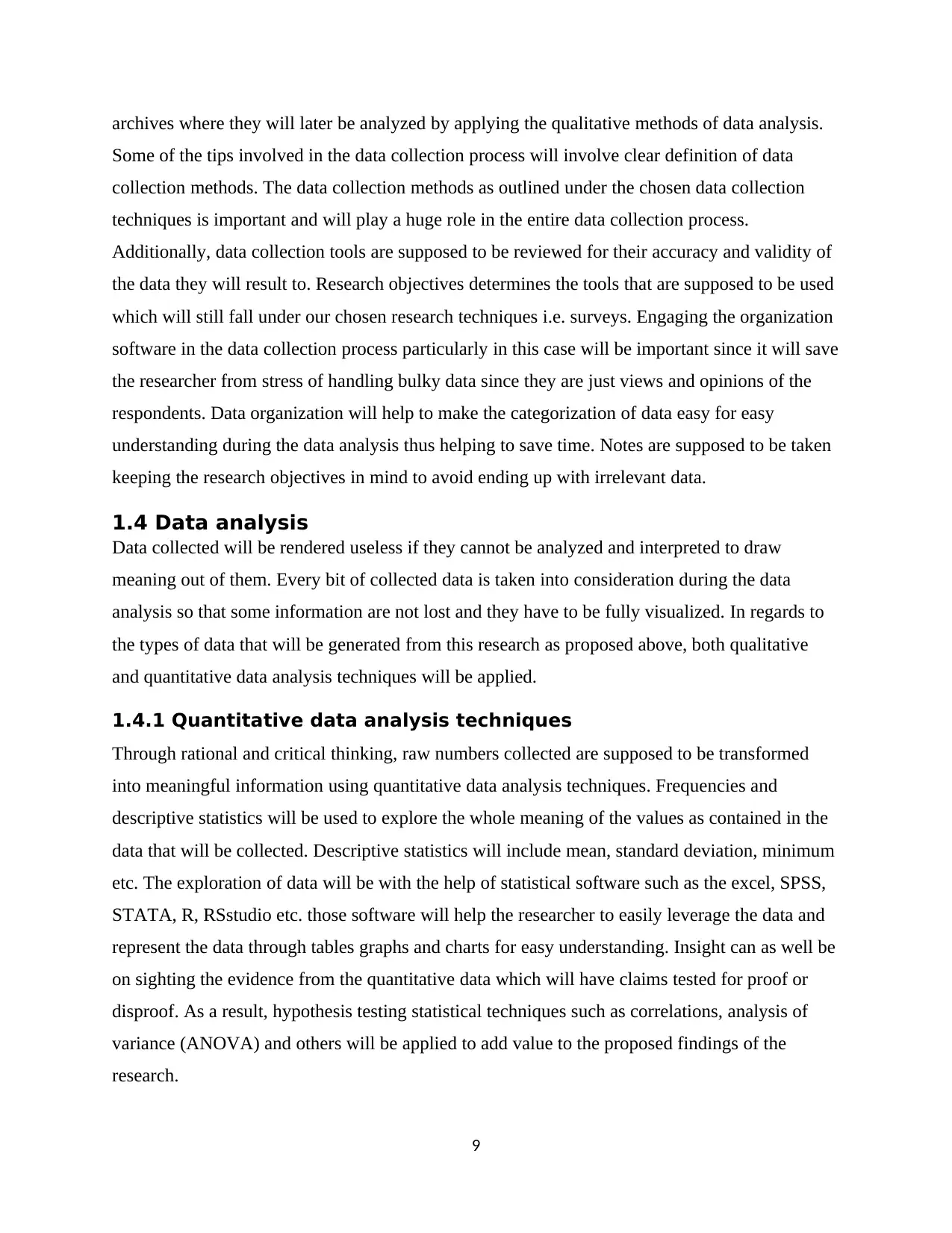
archives where they will later be analyzed by applying the qualitative methods of data analysis.
Some of the tips involved in the data collection process will involve clear definition of data
collection methods. The data collection methods as outlined under the chosen data collection
techniques is important and will play a huge role in the entire data collection process.
Additionally, data collection tools are supposed to be reviewed for their accuracy and validity of
the data they will result to. Research objectives determines the tools that are supposed to be used
which will still fall under our chosen research techniques i.e. surveys. Engaging the organization
software in the data collection process particularly in this case will be important since it will save
the researcher from stress of handling bulky data since they are just views and opinions of the
respondents. Data organization will help to make the categorization of data easy for easy
understanding during the data analysis thus helping to save time. Notes are supposed to be taken
keeping the research objectives in mind to avoid ending up with irrelevant data.
1.4 Data analysis
Data collected will be rendered useless if they cannot be analyzed and interpreted to draw
meaning out of them. Every bit of collected data is taken into consideration during the data
analysis so that some information are not lost and they have to be fully visualized. In regards to
the types of data that will be generated from this research as proposed above, both qualitative
and quantitative data analysis techniques will be applied.
1.4.1 Quantitative data analysis techniques
Through rational and critical thinking, raw numbers collected are supposed to be transformed
into meaningful information using quantitative data analysis techniques. Frequencies and
descriptive statistics will be used to explore the whole meaning of the values as contained in the
data that will be collected. Descriptive statistics will include mean, standard deviation, minimum
etc. The exploration of data will be with the help of statistical software such as the excel, SPSS,
STATA, R, RSstudio etc. those software will help the researcher to easily leverage the data and
represent the data through tables graphs and charts for easy understanding. Insight can as well be
on sighting the evidence from the quantitative data which will have claims tested for proof or
disproof. As a result, hypothesis testing statistical techniques such as correlations, analysis of
variance (ANOVA) and others will be applied to add value to the proposed findings of the
research.
9
Some of the tips involved in the data collection process will involve clear definition of data
collection methods. The data collection methods as outlined under the chosen data collection
techniques is important and will play a huge role in the entire data collection process.
Additionally, data collection tools are supposed to be reviewed for their accuracy and validity of
the data they will result to. Research objectives determines the tools that are supposed to be used
which will still fall under our chosen research techniques i.e. surveys. Engaging the organization
software in the data collection process particularly in this case will be important since it will save
the researcher from stress of handling bulky data since they are just views and opinions of the
respondents. Data organization will help to make the categorization of data easy for easy
understanding during the data analysis thus helping to save time. Notes are supposed to be taken
keeping the research objectives in mind to avoid ending up with irrelevant data.
1.4 Data analysis
Data collected will be rendered useless if they cannot be analyzed and interpreted to draw
meaning out of them. Every bit of collected data is taken into consideration during the data
analysis so that some information are not lost and they have to be fully visualized. In regards to
the types of data that will be generated from this research as proposed above, both qualitative
and quantitative data analysis techniques will be applied.
1.4.1 Quantitative data analysis techniques
Through rational and critical thinking, raw numbers collected are supposed to be transformed
into meaningful information using quantitative data analysis techniques. Frequencies and
descriptive statistics will be used to explore the whole meaning of the values as contained in the
data that will be collected. Descriptive statistics will include mean, standard deviation, minimum
etc. The exploration of data will be with the help of statistical software such as the excel, SPSS,
STATA, R, RSstudio etc. those software will help the researcher to easily leverage the data and
represent the data through tables graphs and charts for easy understanding. Insight can as well be
on sighting the evidence from the quantitative data which will have claims tested for proof or
disproof. As a result, hypothesis testing statistical techniques such as correlations, analysis of
variance (ANOVA) and others will be applied to add value to the proposed findings of the
research.
9
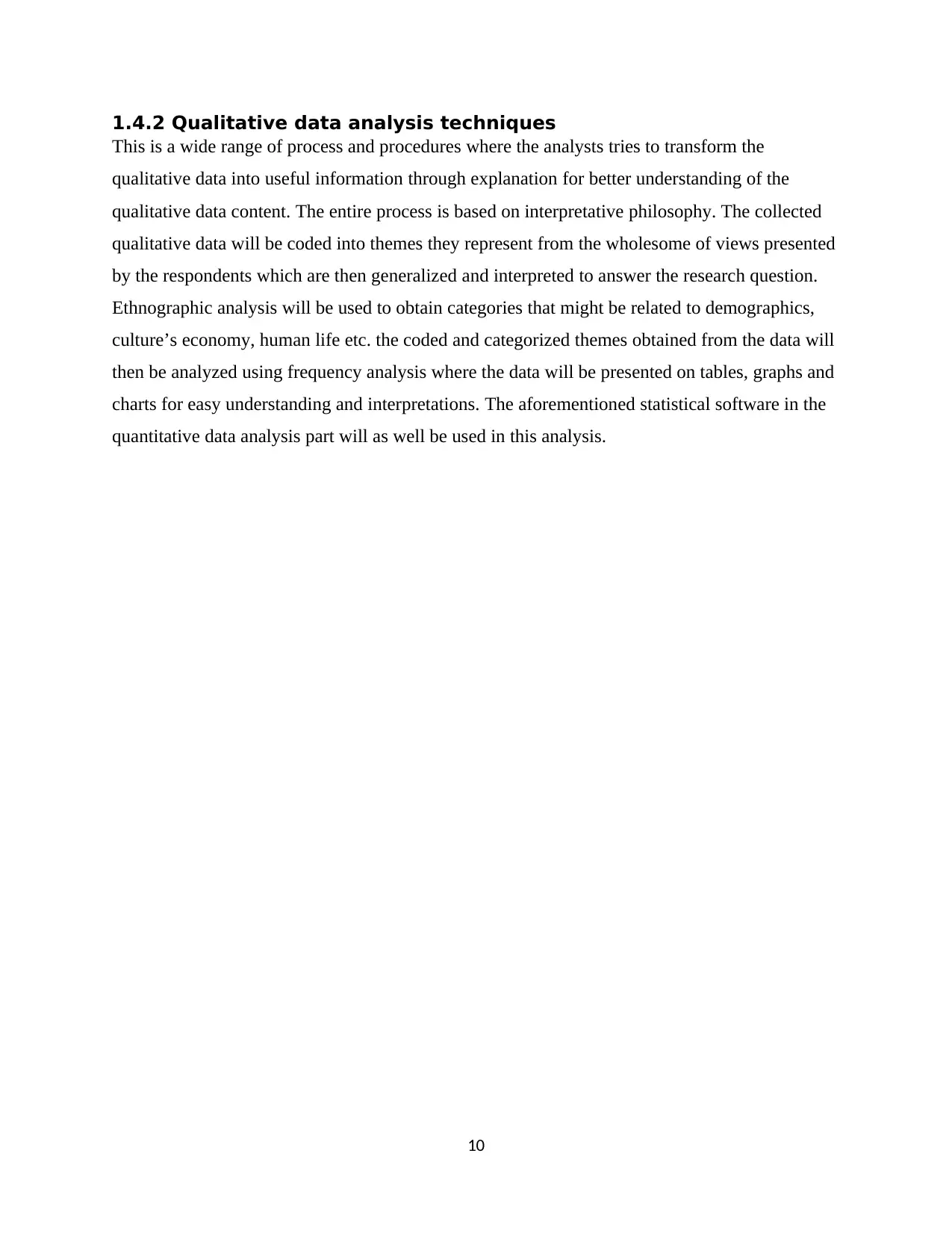
1.4.2 Qualitative data analysis techniques
This is a wide range of process and procedures where the analysts tries to transform the
qualitative data into useful information through explanation for better understanding of the
qualitative data content. The entire process is based on interpretative philosophy. The collected
qualitative data will be coded into themes they represent from the wholesome of views presented
by the respondents which are then generalized and interpreted to answer the research question.
Ethnographic analysis will be used to obtain categories that might be related to demographics,
culture’s economy, human life etc. the coded and categorized themes obtained from the data will
then be analyzed using frequency analysis where the data will be presented on tables, graphs and
charts for easy understanding and interpretations. The aforementioned statistical software in the
quantitative data analysis part will as well be used in this analysis.
10
This is a wide range of process and procedures where the analysts tries to transform the
qualitative data into useful information through explanation for better understanding of the
qualitative data content. The entire process is based on interpretative philosophy. The collected
qualitative data will be coded into themes they represent from the wholesome of views presented
by the respondents which are then generalized and interpreted to answer the research question.
Ethnographic analysis will be used to obtain categories that might be related to demographics,
culture’s economy, human life etc. the coded and categorized themes obtained from the data will
then be analyzed using frequency analysis where the data will be presented on tables, graphs and
charts for easy understanding and interpretations. The aforementioned statistical software in the
quantitative data analysis part will as well be used in this analysis.
10
⊘ This is a preview!⊘
Do you want full access?
Subscribe today to unlock all pages.

Trusted by 1+ million students worldwide
1 out of 15
Related Documents
Your All-in-One AI-Powered Toolkit for Academic Success.
+13062052269
info@desklib.com
Available 24*7 on WhatsApp / Email
![[object Object]](/_next/static/media/star-bottom.7253800d.svg)
Unlock your academic potential
Copyright © 2020–2025 A2Z Services. All Rights Reserved. Developed and managed by ZUCOL.




